|


From One of the
Darkest Places on the Planet,
the Most Wonderful Art
by William Doty, Ph. D.,
William Doty, Ph.D. is Professor Emeritus of Humanities and Religious Studies at the University of Alabama and former
editor of Mythosphere: A Journal for Image, Myth and Symbol. Dr. Doty is a prolific writer, translator, and
editor who has published more than twenty books and seventy essays in a wide range of journals on topics including
religious studies, anthropology, psychology, classics, and art criticism. His best known books include Mythography:
The Study of Myths and Rituals, Myths of Masculinity, and Myth: A Handbook.
That most of the volumes on ancient European Cave Art in my library are cloth-bound, purchased within a year of initial publication, may indicate the depth of my interest in such "pre-historical" mythical creations. It is keyed as well to my Native American Indian studies, since in both cases we are referring to civilizations as old as 30-40,000 BP (before the present). To be sure, documentations of European sites have had more exposure, but those for areas in the Americas are quite convincing to many scholars, and the old chestnut according to which "civilization first arose in Mesopotamia, China, or Africa" has to be reconsidered.
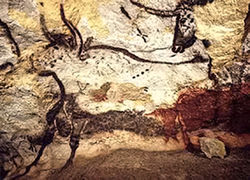 The Cave Painters: Probing the Mysteries of the World's First Artists, by editor and writer Gregory Curtis, is a fine accounting for this "prehistory" — by which we refer, usually in a trivializing manner (hence my quotation marks, what Brits refer to as "scare marks"), to pre-literate or pre-technological societies. The book is as well a useful chronicle of the learned folks who explored the caves during the last 150 years. Many of the art-history/archaeology giants are discussed, with a simultaneous sensitivity on the part of Curtis to the apparently-chance discoveries: as of Lascaux's treasures in the 1940s, by schoolboys, among whom several had fled from the Nazis in Germany. The Cave Painters: Probing the Mysteries of the World's First Artists, by editor and writer Gregory Curtis, is a fine accounting for this "prehistory" — by which we refer, usually in a trivializing manner (hence my quotation marks, what Brits refer to as "scare marks"), to pre-literate or pre-technological societies. The book is as well a useful chronicle of the learned folks who explored the caves during the last 150 years. Many of the art-history/archaeology giants are discussed, with a simultaneous sensitivity on the part of Curtis to the apparently-chance discoveries: as of Lascaux's treasures in the 1940s, by schoolboys, among whom several had fled from the Nazis in Germany.
Curtis balances his extensive learning — attained not only from readings, but also site visits — with a raft of sharp insights and well-informed observations. An example would be his recognition that some of the artworks display "a mastery of perspective [in sculptures and paintings] that was lost in western art until Pablo Uccello [and I would add, several other artists] in the fifteenth century" (legend to plate 6, and see p. 10).
He presents a number of smart, down-home observations that are miles away from some of the rather spacey interpretations such as the proposed dominance of shamanic motifs in the caves (Clottes and Lewis-Williams) — most of which I do accept as appropriate within what we know of societies in which shamanism is regnant. He refuses, for instance, to consider all "primitive" societies as monolithic: we should remember that not everyone entered the caves for the same ritualistic reason/s, nor were they all great artists (10). And he is dead right in noting the contemporary rejection of the long-dominant beliefs in evolution from primitive to sophisticated levels of artistic practice (13): precisely what the last century of ethnography, art history, and archaeology has taught us is that already at the dawn of the "first recorded civilization in history" (15; about 30-40,000 BP), artistic refinements were practiced that would be attained elsewhere only thousands of years later.
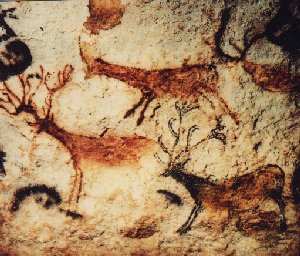 And he recognized that, before writing, so many repeated art conventions that span millennia in cave art must have been transmitted by artistic guilds or "schools" (19) — and that artists probably did not aim at display of individual style or genius (98), in contrast to modern convention. Oddly enough, the first great transcriber, the Abbé Henri Breuil (1877-1961), while already combating the simplistic model of smooth (as opposed to "punctuated") evolutionary development and devoted rather religiously to carefully detailed renderings of individual wall images, seldom posed questions as to what these fabulous mythic images meant (75; I am using "mythic" here in the sense of long-term-important — it need not refer only to texts). And he recognized that, before writing, so many repeated art conventions that span millennia in cave art must have been transmitted by artistic guilds or "schools" (19) — and that artists probably did not aim at display of individual style or genius (98), in contrast to modern convention. Oddly enough, the first great transcriber, the Abbé Henri Breuil (1877-1961), while already combating the simplistic model of smooth (as opposed to "punctuated") evolutionary development and devoted rather religiously to carefully detailed renderings of individual wall images, seldom posed questions as to what these fabulous mythic images meant (75; I am using "mythic" here in the sense of long-term-important — it need not refer only to texts).
What is now ironically self-evident as well is that the priest's artistic vision that gave the world the sheer beauty of the paintings, quite obscured observations that became obvious only in subsequent studies (66), namely that the animal figures were seldom represented in attitudes natural to the classic art atelier, the isolated individual of Modernism, but resulted instead from constant over-painting (or -etching). Hence more recent representations, especially in photographs, portray what linguists would refer to in writing as palimpsests (something like what a photographer might produce by multiple exposures onto a single sheet of photographic paper).
While not primarily an art critic by trade, Curtis has learned or recognized useful information as to how we are to understand the production and significance of the cave art (mostly "parietal," on the walls, but also in sculptural forms and in the overall design of the passageways). The cave art world was one where humans were located only at the lesser, outer ring of the significance of the animal world, and were seldom portrayed: it was "a world ordained for animals" (20), and each cave complex tends to feature only one animal species. Although Lascaux and other sites were lighted only minimally by small flickering oil lamps (yet to be found in the caves) and tiny fires — and were otherwise unremittingly lightless — there were sometimes, as at Lascaux, openings such that at sunset, during certain seasons, the late sunrays penetrate quite far into the caverns (95).
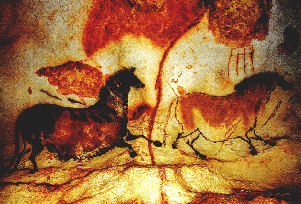 Even while it was common for the walls of a cave to feature one animal more than another (at Lascaux, the horse, but the four huge, black bulls there are among its most famous images), yet it has become increasingly clear that abstract, geometric symbols and designs appear frequently (about one-fifth of the motifs at Lascaux, 97): from here one might step easily into the astonishingly complex Mayan astronomical calculations and glyphic writing on this continent, initially developing fairly closely in time to these European materials. Even while it was common for the walls of a cave to feature one animal more than another (at Lascaux, the horse, but the four huge, black bulls there are among its most famous images), yet it has become increasingly clear that abstract, geometric symbols and designs appear frequently (about one-fifth of the motifs at Lascaux, 97): from here one might step easily into the astonishingly complex Mayan astronomical calculations and glyphic writing on this continent, initially developing fairly closely in time to these European materials.
Rather than featuring individual achievements — whether priestly or shamanic— the cave scenes are very much team projects (99) requiring careful orchestration and planning, as natural geological surfaces are incorporated in order to highlight muscle masses, or complete dramatic scenarios experienced as participants moved through the spaces clearly designed for 3-D perceptions (103). Obvious use of scaffolding to reach high locations for paintings (105) implies the presence of cadres of helpers.
In the late 1930s, Max Raphael perceived that adequate interpretation should focus upon whole compositions, as he stressed the vibrant and transforming aspects of Paleolithic cultures — although he was then ignored for about twenty years (122-24). His follower, Annette Laming-Emperaire (1917-77), brought the question of possible meanings (Fr. signification) to the fore (136) as she emphasized how important for interpretation ethnographic contexts were: graphic masks represented in many images, could be used for widely differing purposes (140-41).
Her thesis adviser, André Leroi-Gourhan (1911-86) came to dominate "archaeology and anthropology in post-war France in the same way that Jean-Paul Sartre dominated philosophy" (148). He focused especially upon the process of making things (chaîne opératoire, 159), such as objects found in the caves and used in the production of the parietal paintings. What an important moment in archaeology and in the recent discovery of the meanings of these earliest visual representations of human art: Leroi-Gourhan recognized that the usual deep-trench explorations/excavations might obscure more than they revealed (156). Think of a Happy Birthday cake: a vertical trench would cut through layers of apparently meaningless sugar confection, but in horizontal sections, the overall design manifests itself.
Leroi-Gourhan also utilized elementary database chartings on file cards, so that "horse" in one site could be readily compared to those in others (161). Thus he laid the groundwork for the statistical computer analyses so important in evaluating contemporary archeological findings.
The recent discovery of the caves at Chauvet and Cosquer in the 1990s — the former accessible only from beneath the current sea surface — are closest to our own day. Artifacts and paintings at Chauvet in particular — in conjunction with continued improvements of radiocarbon dating — have led to radically earlier datings of European cave art, to 27-25,000 years, that is to say, 4,000 years before any other known cave art (209). And most significant: the art in these caves (predating the Lascaux sites by about 14,000 years) is just as sophisticated as any later artworks.
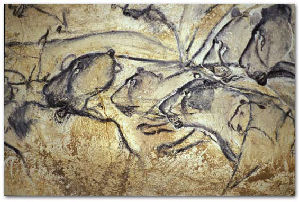 Geometric signs are present here already — and a number of threatening animals, many more than at the later Lascaux: "Perhaps [...] the ancient hunters successfully reduced the number of dangerous animals so that they became less of a threat. That would mean, inevitably, that the myths of these prehistoric societies would change as well" (210). So we can see here a need to look beyond merely psychological projections to changes caused by environmental alterations. Geometric signs are present here already — and a number of threatening animals, many more than at the later Lascaux: "Perhaps [...] the ancient hunters successfully reduced the number of dangerous animals so that they became less of a threat. That would mean, inevitably, that the myths of these prehistoric societies would change as well" (210). So we can see here a need to look beyond merely psychological projections to changes caused by environmental alterations.
Curtis is no wild imaginist, and I think he is right on beam in suggesting a possible comparison between a scene at Chauvet in which — the scene is not accessible, but an innovative archaeologist (Yanik Le Guillon) sent into the interior a digital camera mounted on a collapsible metal arm — a bison and a female human are placed close alongside one another. Such a scene cannot but suggest a mythical parallel with Zeus manifest in bull form carrying Europa to Crete and raping her (218), conceiving Minos, ruler of Crete. But what is most striking in this instance is that the Greek scene is very much younger than this scenario in central Europe.
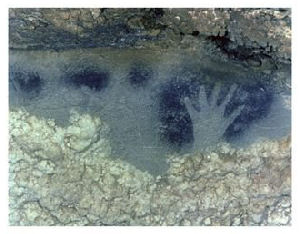 With Clottes and Lewis-Williams, we had a suggestion that in one of the frequent motifs within cave art — a handprint made by placing a hand on a surface and blowing paint or pigment over it, leaving a sharply-defined outline — sometimes, perhaps, because of some fingers being folded down before the spraying — we have representations of clan marks (Curtis 129, 145, 196). Clottes and Lewis-Williams interpret the hands as an indication of humans transcending, going-beyond the limits of temporal reality, as represented visually by the surfaces of the walls themselves (223). These authors also suggest that the animals on the walls were hallucinatory or trance figures (223-25). With Clottes and Lewis-Williams, we had a suggestion that in one of the frequent motifs within cave art — a handprint made by placing a hand on a surface and blowing paint or pigment over it, leaving a sharply-defined outline — sometimes, perhaps, because of some fingers being folded down before the spraying — we have representations of clan marks (Curtis 129, 145, 196). Clottes and Lewis-Williams interpret the hands as an indication of humans transcending, going-beyond the limits of temporal reality, as represented visually by the surfaces of the walls themselves (223). These authors also suggest that the animals on the walls were hallucinatory or trance figures (223-25).
Curtis suggests that contemporary specialists have ignored such (226-27), and he proposes instead — intriguingly — that such cave artists were more fundamentally conservative ("the triumphs of the first classical civilization," 229) than his own earlier suggestions might have intimated.
One book design found in this publication that irritates me is the use of endnotes identifying sources of information that appear without the slightest advance notice after the last page of text. On the other hand, the twenty-one page bibliography (in English and French only) is extraordinarily fulsome.
Screening the Moyers/Campbell The Power of Myth film "The Earliest Storytellers" (number 3 in the videotape series) in a seminar recently, I was once again touched very deeply by a number of the intense cave art images projected at the beginning of and half-way through the film. Joseph Campbell records how he was strongly moved by visiting the caves. Few are still open to the public because the many visitors were bringing into the caves airborne pathogenic substances that began to ruin surfaces of the irreparable cave paintings.
My own experience in the 1970s of entering a model of an underground chamber at the Prado in Madrid was just as striking. I do not remember how we made our way to our lounges, but I certainly recall that it took about fifteen minutes before our eyes adjusted to the originally-natural low light of the replicated Altamira cave scenes. All of a sudden, we were in the presence of genuine antiquity, astonishingly-frisky gazelles, and oh so many other animals. No wonder Campbell would title the first volume of his Historical Atlas of World Mythology The Way of the Animal Powers!
Selected Bibliography
-
-
Campbell, Joseph. 1988. The Way of the Animal Powers. Vol. 1 of Historical Atlas of World Mythology (in two parts in the paperback edition). New York: Perennial Library-Harper and Row.
Chauvel, Jean-Marie; Éliette Brunel Deschamps; and Christian Hillaire. 1996. Dawn of Art: The Chauvet Cave. The Oldest Known Paintings in the World. Trans. Paul G. Bahn. New York: Abrams.
Clottes, Jean, and David Lewis-Williams. 1998 (French, 1996). The Shamans of Prehistory: Trance and Magic in the Painted Caves. Tr. Sophie Hawkes. New York: Abrams.
, and Jean Courlin. 1996. The Cave Beneath the Sea: Paleolithic Images at Cosquer. Trans. Marilyn Garner. New York: Abrams.
Curtis, Gregory. 2007. The Cave Painters: Probing the Mysteries of the World's First Artists. New York: Knopf.
Leroi-Gourhan, André. 1982. The Dawn of European Art: An Introduction to Paleolithic Cave Painting. Trans. S. Champion. New York: Cambridge UP.
Ruspoli, Mario. 1987 (French 1986]. The Cave of Lascaux: The Final Photographs. New York: Abrams.
Sieveking, Ann. 1979. The Cave Artists. Ancient Peoples and Places. New York: Thames and Hudson.
Return to Passages Menu
Subscribe to the Passages e-zine
|

